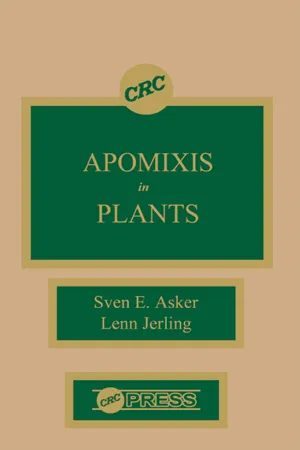![]()
Chapter 1
INTRODUCTION
More than a billion years ago, sexual reproduction probably arose in some kind of primitive unicelled eukaryotes. Organisms like bacteria and blue-green algae where sexual differentiation and fertilization have not yet arisen, although subtle mechanisms for genetic recombination have been revealed, were considered by Winkler23 as amictic. Sexually reproducing organisms were named mictic (or amphimictic). The fusion of two gametes into a zygote and the ensuing meiosis, which somehow developed by modification of mitotic divisions, allows for an exchange of the genetic material provided by the parental sex cells and the production of a multitude of diploid genotypes. Survival and reproduction of the most fit genotypes are then promoted by natural selection.
However obvious the advantages of sex may seem, superficially viewed several groups of plants and animals have left it behind, reproducing mainly or totally by asexual means. Obviously under certain conditions, asexual reproduction is the more favorable strategy of survival. Organisms developed from amphimictic ones, where reproduction is no longer associated with fertilization, were called by Winkler23 apomictic, and their mode of reproduction apomixis — apo meaning “away from” and mixis, “act of mixing”. In this very wide sense, apomixis includes various types of asexual reproduction in plants and animals.
In animals, parthenogenesis, or “virgin birth”, is known from several groups and was described long before similar phenomena in plants (Chapters 2 and 3). To a biologist, it indicates that egg cells divide and develop into new individuals without fertilization.
Parthenogenesis of an uncomplicated type similar to that known from animals exists within various groups of fungi and algae. Parthenogenetic egg cell development also occurs in mosses, ferns, and angiosperms. Here, as in some algae, matters are complicated by the alternations of generations, in sexual taxa usually a sporophyte with the unreduced and a gametophyte with the reduced chromosome number. Special types of asexual reproduction have been described in higher algae, mosses, and ferns as apogamy and apospory (Chapter 4).
We would prefer to restrict the concept of apomixis to angiosperms, although we are well aware that many authors speak about apomixis and apomictic reproduction in animals and lower plants. We do not include various types of vegetative reproduction among the apomictic phenomena; apomixis is then synonymous with asexual seed formation, or agamospermy. Different types of apomixis are described in Chapter 5.
As discussed in Chapter 6, recent progress has been made in studies of the genetic background of apomixis, although we still need more information about its regulation and origin. The connections between apomixis and other traits like polyploidy, hybridization, self-incompatibility, and self-fertilization are discussed in Chapter 7.
Variation and evolution show other patterns in apomictic complexes than in sexual groups and have to be assayed partly by other methods (Chapter 8). Further, the taxonomical treatment of the sometimes large “agamic complexes”, where apomixis occurs in connection with polyploidy and hybridization, is a difficult task. The systematic distribution of apomixis among angiosperm taxa is by no means random (Chapter 9).
A much-debated concept during later years concerns the theoretical advances of sexual vs. asexual reproduction, including apomixis (Chapter 10). The ecological implications of apomixis have been subject to many recent studies (Chapter 11). Many biologists have been interested in geographical trends connected with the distribution of related sexual and apomictic taxa (Chapter 12).
Breeding apomictic crops requires special strategies. During recent years, possibilities have been discussed of inducing apomictic seed formation in crops that are now sexually or vegetatively reproduced, mainly to fix heterosis and hybrid vigor (Chapter 13).
Since Gustafsson’s monograph,11, 13 many authors have surveyed problems related to apomixis and asexual reproduction. To mention only a few of them in chronological order, we have the papers by Stebbins,21 Nygren,17,18 Fryxell,9 Battaglia,4 Rutishauser,20 Doll,8 Grant,10 Williams,22 Khokhlov,14 Maynard-Smith,15 Asker,12 Bara and Ghiorghita,3 Bell,5 Nogler,16 Richards,19 Cuellar,7 and Bilinski et al.6 Especially, we would like to give prominence to the review of gametophytic apomixis by Nogler.16 Most papers discuss only part of the problems, and therefore we feel justified in trying to shed light on the whole area, although by necessity we are not specialists in all branches of apomixis research.
REFERENCES
1. Asker, S., Progress in apomixis research, Hereditas, 91, 231, 1979.
2. Asker, S., Gametophytic apomixis; elements and genetic regulation, Hereditas, 93, 277, 1980.
3. Bara, I. and Ghiorghita, G., Din enigmele evolutiei, Apomixia si Rolul ei in Evolutie. Editura Stiientifica si Enciclopedica, Bucharest, 1980 (Roumanian).
4. Battaglia, E., Apomixis, in Recent Advances in Embryology of the Angiosperms, Maheshwari, P., Ed., 1963, 221.
5. Bell, G., The Masterpiece of Nature. The Evolution and Genetics of Sexuality, Croom Helm, London, 1982.
6. Bilinski, C., Marmiroli, N., and Miller, J., Apomixis in Saccharomyces cerevisiae and Other Eukaryotic Micro-organisms, Ann. Microb. Physiol., 30, 23, 1989.
7. Cuellar, O., The evolution of parthenogenesis: a historical perspective, in Meiosis, Moens, P., Ed., Academic Press, London, 1987, 43.
8. Doll, R., Probleme der Apomixis bei hoheren Pflanzen, Biol. Rundschau, 9, 215, 1971.
9. Fryxell, P. A., Mode of reproduction in higher plants, Bot. Rev., 23, 135, 1957.
10. Grant, V., Plant Speciation, 2nd ed., Columbia University Press, New York, 1981.
11. Gustafsson, Å., Apomixis in higher plants. I, The mechanism of apomixis, Lunds Univ. Årsskr. N. F. Avd. 2, 42(3), 1, 1946.
12. Gustafsson, Å., Apomixis in higher plants. II, The causal aspect of apomixis, Lunds Univ. Årsskr. N. F. Avd. 2, 43(2), 71, 1947.
13. Gustafsson, Å., Apomixis in higher plants. Ill, Biotype and species formation, Lunds Univ. Årsskr. N. F. Avd. 2, 43(12), 183, 1947.
14. Khokhlov, S. S., Evolutionary-genetic problems of apomixis in angiosperms, in Apomixis and Plant Breeding, Khokhlov, S. S., Ed., Amerind, New Delhi, 1976, 3.
15. Maynard-Smith, J., The Evolution of Sex, Cambridge University Press, Cambridge, 1978.
16. Nogler, G. A., Gametophytic apomixis, in Embryology of Angiosperms, Johri, B. M., Ed., Springer-Verlag, Berlin, 1984, 475.
17. Nygren, A., Apomixis in the angiosperms. II, Bot. Rev., 20, 577, 1954.
18. Nygren, A., Apomixis in the angiosperms, in Handbuch der Pflanzen...
